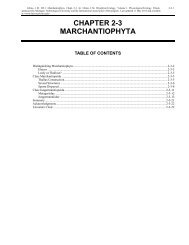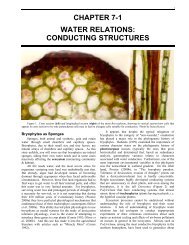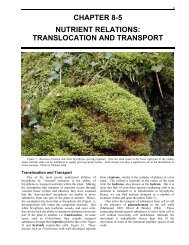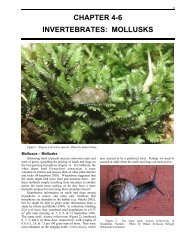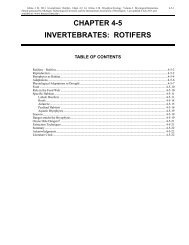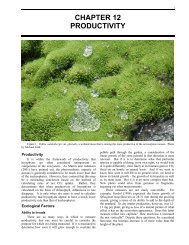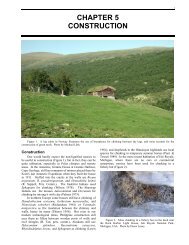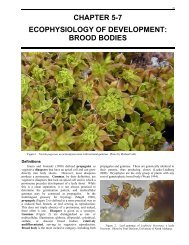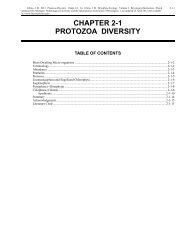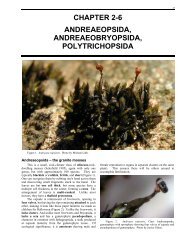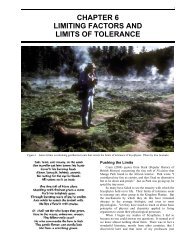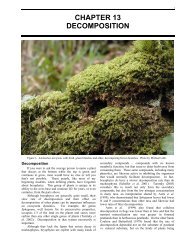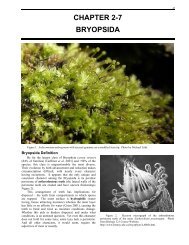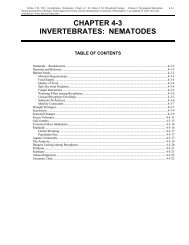Chapter 5-4: Tardigrades: Species Relationships - Bryophyte Ecology
Chapter 5-4: Tardigrades: Species Relationships - Bryophyte Ecology
Chapter 5-4: Tardigrades: Species Relationships - Bryophyte Ecology
Create successful ePaper yourself
Turn your PDF publications into a flip-book with our unique Google optimized e-Paper software.
CHAPTER 5-4<br />
TARDIGRADES: SPECIES<br />
RELATIONSHIPS<br />
Figure 1. Hypsibius dujardini, a species that is common on bryophytes. Photo by Łukasz Kaczmarek and Łukasz Michalczyk.<br />
<strong>Species</strong> <strong>Relationships</strong><br />
Since bryophytes vary widely in structure,<br />
compactness, and moisture-holding nature, one would<br />
expect that some bryophytes would be more suitable for<br />
tardigrades than others, causing specificity. But is that<br />
really the case?<br />
Although Hofmann and Eichelberg (1987), in Lahnau<br />
near Giessen, Germany, found a correlation between<br />
species of tardigrade and degree of moisture in their<br />
preferred mosses, there seemed to be no example of a<br />
single species of tardigrade preferring a single species of<br />
moss. It appeared that species of bryophyte was not an<br />
important factor for most tardigrades.<br />
A number of studies include the names of the<br />
bryophytes where the tardigrades have been found, but<br />
quantitative approaches are limited. For example, Degma<br />
(2006) found Echiniscus reticulatus on the moss Ctenidium<br />
molluscum (Figure 2) and Testechiniscus spitsbergensis<br />
from the mosses Tortella tortuosa (Figure 3), Ctenidium<br />
molluscum, Distichium capillaceum (Figure 4), and<br />
Ditrichum flexicaule (Figure 5) in Slovakia.<br />
Baxter (1979) did find differences in the tardigrades on<br />
several moss species in Ireland. These represented<br />
different growth forms as well as habitats. Some of their<br />
more specific finds include stream bank mosses that had<br />
Diphascon oculatum. Polytrichum (Figure 6), with its<br />
more open structure, had Diphascon scoticum (Figure 7).<br />
Hypsibius dujardini (Figure 1) was abundant, accompanied<br />
by Isohypsibius tuberculatus, on the turfs of<br />
Rhytidiadelphus squarrosus (Figure 8).<br />
Figure 2. Ctenidium molluscum, a moss that is home to<br />
Echiniscus reticulatus, among others. Photo by Michael Lüth.<br />
45
46 <strong>Chapter</strong> 5-4: <strong>Tardigrades</strong>: <strong>Species</strong> <strong>Relationships</strong><br />
Figure 3. Tortella tortuosa, a Slovakian habitat for<br />
Testechiniscus spitsbergensis. Photo by Michael Lüth.<br />
Figure 4. Distichium capillaceum, a known tardigrade<br />
habitat. Photo by Michael Lüth.<br />
Figure 5. Ditrichum flexicaule, a habitat for Testechiniscus<br />
spitsbergensis. Photos by Michael Lüth.<br />
Figure 6. Polytrichum, a moss with spreading leaves that<br />
provide limited tardigrade habitat. Photo by Michael Lüth.<br />
Figure 7. Diphascon scoticum, a tardigrade that is able to<br />
inhabit Polytrichum. Photo by Paul Bartels.<br />
Figure 8. Rhytidiadelphus squarrosus, where Baxter (1979)<br />
found Isohypsibius tuberculatus and Diphascon scoticum. Photo<br />
by Michael Lüth.<br />
Horning et al. (1978) examined the tardigrades on 21<br />
species of mosses in New Zealand and listed the tardigrade<br />
species on each (Table 1). Some moss species clearly had<br />
more tardigrade species than others, ranging from 1 on<br />
Syntrichia rubra to 17 on Hypnum cupressiforme (Figure<br />
9). Limbophyllum divulsulum had 16 species.
<strong>Chapter</strong> 5-4: <strong>Tardigrades</strong>: <strong>Species</strong> <strong>Relationships</strong> 47<br />
Table<br />
1. Tardigrade species found on the most common moss taxa in New Zealand. From Horning et al. 1978.<br />
Breutelia elongata Macrobiotus hibiscus<br />
Macrobiotus liviae<br />
Milnesium tardigradum<br />
Minibiotus intermedius<br />
Breutelia pendula Diphascon prorsirostre<br />
Diphascon scoticum<br />
Doryphoribius zyxiglobus<br />
Hypechiniscus exarmatus<br />
Macrobiotus hibiscus<br />
Macrobiotus liviae<br />
Milnesium tardigradum<br />
Bryum campylothecium Hypsibius convergens<br />
Isohypsibius sattleri<br />
Minibiotus intermedius<br />
Bryum dichotomum Hypsibius wilsoni<br />
Macrobiotus coronatus<br />
Macrobiotus liviae<br />
Bryum truncorum Diphascon chilenense<br />
Diphascon scoticum<br />
Isohypsibius sattleri<br />
Isohypsibius wilsoni<br />
Macrobiotus coronatus<br />
Macrobiotus furciger<br />
Macrobiotus liviae<br />
Macrobiotus recens<br />
Paramacrobiotus areolatus<br />
Paramacrobiotus richtersi<br />
Ramazzottius oberhaeuseri<br />
Dicranoloma billardieri Hypechiniscus exarmatus<br />
Macrobiotus hibiscus<br />
Dicranoloma grossialare Diphascon prorsirostre<br />
Hypechiniscus exarmatus<br />
Hypsibius dujardini<br />
Isohypsibius cameruni<br />
Isohypsibius sattleri<br />
Limmenius porcellus<br />
Macrobiotus anderssoni<br />
Macrobiotus hibiscus<br />
Macrobiotus liviae<br />
Milnesium tardigradum<br />
Pseudechiniscus novaezeelandiae<br />
Dicranoloma menziesii Macrobiotus hibiscus<br />
Macrobiotus liviae<br />
Paramacrobiotus areolatus<br />
Dicranoloma robustum Echiniscus bigranulatus<br />
Macrobiotus anderssoni<br />
Macrobiotus furciger<br />
Macrobiotus liviae<br />
Milnesium tardigradum<br />
Pseudechiniscus suillus<br />
Dicranoloma trichopodum Echiniscus quadrispinosus<br />
Echiniscus q. brachyspinosus<br />
Macrobiotus furciger<br />
Pseudechiniscus lateromamillatus<br />
Hypnum cupressiforme Diphascon alpinum<br />
Diphascon bullatum<br />
Echiniscus quadrispinosus<br />
Echiniscus spiniger<br />
Hypsibius dujardini<br />
Macrobiotus anderssoni<br />
Macrobiotus coronatus<br />
Macrobiotus furciger<br />
Macrobiotus hibiscus<br />
Macrobiotus liviae<br />
Macrobiotus recens<br />
Milnesium tardigradum<br />
Oreella mollis<br />
Paramacrobiotus areolatus<br />
Pseudechiniscus novaezeelandiae<br />
Pseudechiniscus suillus<br />
Ramazzottius oberhaeuseri<br />
Lembophyllum divulsum Diphascon alpinum<br />
Doryphoribius zyxiglobus<br />
Hypsibius convergens<br />
Isohypsibius sattleri<br />
Macrobiotus anderssoni<br />
Macrobiotus coronatus<br />
Macrobiotus furciger<br />
Macrobiotus hibiscus<br />
Macrobiotus liviae<br />
Macrobiotus recens<br />
Macrobiotus subjulietae<br />
Milnesium tardigradum<br />
Minibiotus intermedius<br />
Paramacrobiotus areolatus<br />
Pseudechiniscus novaezeelandiae<br />
Pseudechiniscus suillus<br />
Macromitrium erosulum Macrobiotus furciger<br />
Macrobiotus hibiscus<br />
Macrobiotus liviae<br />
Pseudechiniscus suillus<br />
Macromitrium longipes Doryphoribius zyxiglobus<br />
Hypsibius convergens<br />
Macrobiotus recens<br />
Minibiotus intermedius<br />
Porotrichum ramulosum Diphascon alpinum<br />
Diphascon scoticum<br />
Doryphoribius zyxiglobus<br />
Echiniscus bigranulatus<br />
Hypsibius convergens<br />
Macrobiotus anderssoni<br />
Macrobiotus coronatus<br />
Macrobiotus furciger<br />
Macrobiotus hibiscus<br />
Macrobiotus liviae<br />
Macrobiotus rawsoni<br />
Minibiotus aculeatus<br />
Pseudechiniscus lateromamillatus<br />
Pseudechiniscus novaezeelandiae<br />
Pseudechiniscus suillus<br />
Racomitrium crispulum Calohypsibius ornatus<br />
Diphascon alpinum<br />
Echiniscus quadrispinosus<br />
Echiniscus zetotrymus<br />
Hebesuncus conjungens<br />
Hypsibius convergens<br />
Isohypsibius wilsoni<br />
Macrobiotus anderssoni<br />
Macrobiotus coronatus<br />
Macrobiotus furciger<br />
Macrobiotus hibiscus<br />
Macrobiotus orcadensis<br />
Milnesium tardigradum<br />
Oreella minor<br />
Paramacrobiotus areolatus<br />
Pseudechiniscus suillus<br />
Racomitrium lanuginosum Diphascon scoticum<br />
Echiniscus quadrispinosus brachyspinosus<br />
Echiniscus vinculus<br />
Hebesuncus conjungens<br />
Macrobiotus furciger<br />
Milnesium tardigradum<br />
Minibiotus intermedius<br />
Oreella mollis<br />
Pseudechiniscus suillus<br />
Racomitrium ptychophyllum Echiniscus quadrispinosus<br />
Echiniscus velaminis<br />
Hebesuncus conjungens<br />
Hypechiniscus exarmatus<br />
Hypsibius dujardini<br />
Macrobiotus furciger<br />
Milnesium tardigradum<br />
Minibiotus intermedius<br />
Oreella mollis<br />
Syntrichia princeps Hypsibius convergens<br />
Ramazzottius oberhaeuseri<br />
Isohypsibius wilsoni<br />
Macrobiotus coronatus<br />
Macrobiotus recens<br />
Milnesium tardigradum<br />
Pseudechiniscus novaezeelandiae<br />
Syntrichia rubra Diphascon scoticum<br />
Tortula subulata var. serrulata Diphascon scoticum<br />
Paramacrobiotus areolatus
48 <strong>Chapter</strong> 5-4: <strong>Tardigrades</strong>: <strong>Species</strong> <strong>Relationships</strong><br />
Figure 9. Hypnum cupressiforme, the moss with the most tardigrade species in the New Zealand study by Horning et al. (1978),<br />
shown here on rock and as a pendant epiphyte. Photos by Michael Lüth.<br />
Hopefully lists like the one provided by Horning et al.<br />
(1978) will eventually permit us to determine the<br />
characteristics that foster tardigrade diversity and<br />
abundance. Perhaps the moss Hypnum cupressiforme had<br />
the most tardigrade species among the mosses in New<br />
Zealand because of its own wide habitat range there.<br />
However, Degma et al. (2005) found that distribution of the<br />
number of tardigrade species on this moss in their Slovakia<br />
sites was random, as supported by a Chi-square goodness<br />
of fit test. Nevertheless, its ubiquitous nature on a wide<br />
range of habitats in New Zealand may account for the<br />
greater number of species of tardigrades on Hypnum<br />
cupressiforme in the New Zealand study.<br />
A different kind of vertical zonation occurs among<br />
tardigrades on trees. In the Great Smoky Mountains<br />
National Park, the number of tardigrade species among<br />
epiphytes at breast height was greater than the number of<br />
species found at the base (Bartels & Nelson 2006).<br />
In a study of 270 Chinese mosses in the Herbarium of<br />
the Missouri Botanical Garden, only 78 specimens,<br />
representing 10 locations, had tardigrades (Beasley &<br />
Miller 2007). These were represented by 12 species.<br />
Several additional species were found and may be new<br />
species, but more specimens are needed to make adequate<br />
determinations. In this study, the mosses were identified<br />
and I present the moss and fauna here to facilitate<br />
comparisons for persons looking for possible specificity in<br />
conjunction with other studies (Table 2).<br />
In their study of Chinese mosses Beasley and Miller<br />
(2007) found that Heterotardigrada (armored tardigrades)<br />
were better represented than were Eutardigrada<br />
(unarmored tardigrades), a factor the authors attribute to the<br />
xerophilic moss samples and the locality, which has hot,<br />
dry summers, very cold, dry winters, low summer rainfall,<br />
and high winds (Fullard 1968). The Heterotardigrada have<br />
armor, which may account for their ability to withstand the<br />
dry habitat. These tardigrades also have cephalic (head)<br />
appendages with a sensorial function, a character lacking in<br />
the Eutardigrada, but so far their function has not been<br />
related to a bryophyte habitat. Beasley and Miller (2007)<br />
found little specificity, but most of the mosses they<br />
examined were xerophytic and exhibited similar moisture<br />
requirements. They did find that Echiniscus testudo (see<br />
Figure 11) occurred on a wider variety of mosses than did<br />
other tardigrade species.<br />
Table 2. Distribution of tardigrades on specific mosses in<br />
Xinjiang Uygur Region, China, based on herbarium specimens.<br />
From Beasley & Miller 2007.<br />
tardigrade numb/samples moss<br />
Bryodelphax asiaticus 1/1 Pseudoleskeella catenulata<br />
Cornechiniscus holmeni 18/5 Grimmia tergestina<br />
Mnium laevinerve<br />
Schistidium sp.<br />
Echiniscus blumi 4/4 Abietinella abietina<br />
Schistidium sp.<br />
Echiniscus canadensis 82/7 Grimmia laevigata<br />
Grimmia ovalis<br />
Grimmia tergestina<br />
Echiniscus granulatus 8/3 Grimmia longirostris<br />
Schistidium trichodon<br />
Schistidium sp.<br />
Echiniscus testudo 11/4 Grimmia anodon<br />
Grimmia longirostris<br />
Grimmia tergestina<br />
Lescuraea incurvata<br />
Pseudoleskeella catenulata<br />
Schistidium sp.<br />
Echiniscus trisetosus 33/5 Abietinella abietina<br />
Grimmia ovalis<br />
Pseudoleskeella catenulata<br />
Macrobiotus mauccii 2/2 Schistidium sp.<br />
Milnesium asiaticum 10/4 Grimmia anodon<br />
Grimmia tergestina<br />
Grimmia ovalis<br />
Schistidium sp.<br />
Milnesium longiungue 4/2 Grimmia laevigata<br />
Grimmia ovalis<br />
Milnesium tardigradum 5/4 Grimmia tergestina<br />
Grimmia ovalis<br />
Orthotrichum sp.<br />
Paramacrobiotus alekseevi 5/4 Brachythecium albicans<br />
Schistidium sp.<br />
Figure 10. Macrobiotus hufelandi. Photo by Martin Mach.
Figure 11. Adult Echiniscus. Photo by Martin Mach.<br />
Kathman and Cross (1991) found that species of<br />
bryophyte had no influence on the distribution or<br />
abundance of tardigrades from five mountains on<br />
Vancouver Island, British Columbia, Canada. Despite a<br />
lack of specificity among the tardigrades, 39 species<br />
inhabited these 37 species of mountain bryophytes,<br />
comprising 14,000 individuals. Several researchers<br />
contend that any terrestrial species of tardigrade can be<br />
found on any species of moss, given the "appropriate<br />
microhabitat conditions" (Bertrand 1975; Ramazzotti &<br />
Maucci 1983). If these tardigrade bryophyte specialists<br />
find no differences among the bryophytes, can we blame<br />
the ecologists for lumping all the bryophytes in their<br />
studies as well?<br />
On Roan Mountain in Tennessee and North Carolina,<br />
Nelson (1973, 1975) found no specificity among 21<br />
tardigrade species on 25 bryophyte species. Hunter (1977)<br />
in Montgomery County, Tennessee, and Romano et al.<br />
(2001) in Choccolocco Creek in Alabama, USA, again<br />
were unable to find any dependence of tardigrades upon a<br />
particular species of bryophyte in their collections. In fact,<br />
Kathman and Cross (1991) were unable to find any<br />
correlation with altitude or aspect throughout a span from<br />
150 to 1525 m. They concluded that it was the presence of<br />
bryophyte that determined tardigrade presence, not the<br />
species of bryophyte, altitude, or locality.<br />
In collections from Giessen, Germany, the most<br />
common tardigrade species, the cosmopolitan Macrobiotus<br />
hufelandi, (Figure 10) had no preference for any moss<br />
species (Hofmann 1987). But lack of influence of<br />
bryophyte species may not always be the case. Hofmann<br />
(1987) used a preference index to show that four out of<br />
sixteen tardigrades from Giessen had distinct preferences<br />
among five moss species and that they seemed to prefer<br />
cushion mosses over sheet mosses. Also contrasting with<br />
the above researchers, Bertolani (1983) found that there<br />
seemed to be a species relationship between tardigrades<br />
<strong>Chapter</strong> 5-4: <strong>Tardigrades</strong>: <strong>Species</strong> <strong>Relationships</strong> 49<br />
and coastal dune mosses. It is possible that this is again<br />
related to moisture. The moisture relationship might also<br />
explain why mosses on rotten logs seem to have few<br />
tardigrades. Could it be that they are too wet for too long?<br />
Growth Forms<br />
There is some indication that species differences may<br />
exist, based on growth form. The bryophyte form can<br />
affect the moisture-holding capacity and rate of loss of<br />
moisture. The foregoing evidence suggests that the<br />
moisture-holding capacity of cushion mosses was probably<br />
a desirable trait in that habitat. On the other hand, Beasley<br />
(1990) found that more samples of clubmosses<br />
(Lycopodiaceae) (75%) had tardigrades than did mosses<br />
(46%) or liverworts (0%) in Gunnison County, Colorado.<br />
Jönsson (2003) compared the tardigrade fauna on<br />
mosses in a coniferous forest and those on mosses in an<br />
adjacent clearcut area in Southern Sweden. He found<br />
sixteen tardigrade species, with the cosmopolitan<br />
Macrobiotus hufelandi (Figure 10) being by far the most<br />
common. Wefts had more tardigrades than other mosses.<br />
The forest samples tended to have more species, as one<br />
might expect based on moisture relations.<br />
Kathman and Cross (1991) found that tardigrades from<br />
Vancouver Island were more common on weft-forming<br />
mosses than on turfs, suggesting that the thick carpets of<br />
the wefts were more favorable habitat than the thinly<br />
clustered turfs with their thick rhizoidal mats and attached<br />
soil. Contrasting with some of these findings, and the<br />
preference for cushion mosses in the study by Hofmann<br />
(1987), Diane Nelson (East Tennessee State University,<br />
Johnson City, pers. comm. in Kathman & Cross 1991)<br />
found no preference for sheet or cushion mosses in her<br />
Roan Mountain, Virginia, USA study. Rather, those<br />
tardigrades were more common in thin, scraggly mosses or<br />
in small tufts than in thick cushion mosses.<br />
Sayre and Brunson (1971) compared tardigrade fauna<br />
on mosses in 26 North American collections from a variety<br />
of habitats and substrata (Figure 12). They found that<br />
mosses of short stature in the Thuidiaceae (Figure 13) and<br />
Hypnaceae (Figure 14) had the highest frequencies of<br />
tardigrades. Other moss-dwellers were found in fewer<br />
numbers on members of the moss families Orthotrichaceae<br />
(epiphytic and rock-dwelling tufts; Figure 15),<br />
Leucobryaceae (cushions; Figure 16), Polytrichaceae (tall<br />
turfs; Figure 17), Plagiotheciaceae (low mats; Figure 18),<br />
and Mniaceae (mats & wefts; Figure 19).<br />
Collins and Bateman (2001), studying tardigrade fauna<br />
of bryophytes in Newfoundland, Canada, found that rate of<br />
desiccation of the mosses affected distribution of<br />
tardigrades, and this suggests that bryophyte species and<br />
growth forms that dehydrate quickly should have fewer<br />
individuals and probably different or fewer species than<br />
those that retain water longer (see <strong>Chapter</strong> 4-6). In<br />
different climate regimes, that rate will differ. This may<br />
explain a preference for cushions in some locations and not<br />
in others. Data are needed on humidity within the various<br />
growth forms of bryophytes, correlated with tardigrade<br />
densities, to try to explain why different growth forms<br />
seem to be preferred in different locations.
50 <strong>Chapter</strong> 5-4: <strong>Tardigrades</strong>: <strong>Species</strong> <strong>Relationships</strong><br />
Figure 12. Relative frequency of tardigrades on bryophytes<br />
of various North American substrata. Redrawn from Sayre &<br />
Brunson 1971.<br />
Figure 13. Thuidium delicatulum (Thuidiaceae), a lowstature<br />
moss that is a good tardigrade habitat. Photo by Michael<br />
Lüth.<br />
Figure 14. Hypnum revolutum (Hypnaceae), representing a<br />
family that includes low-stature mosses that had among the<br />
highest frequencies of tardigrades in 26 North American<br />
collections (Sayre & Brunson 1971). Photo by Michael Lüth.<br />
Figure 15. Orthotrichum pulchellum, an epiphytic moss in<br />
the Orthotrichaceae. This family is among those with lower<br />
numbers of tardigrades in the North American study of Sayre &<br />
Brunson (1971) compared to families of mat-forming species.<br />
Photo by Michael Lüth.<br />
Figure 16. Leucobryum glaucum, a cushion moss in the<br />
Leucobryaceae. This family of mosses had lower numbers of<br />
tardigrades than those found in the mat-forming mosses in 26<br />
North American collections (Sayre & Brunson 1971). Photo by<br />
Michael Lüth.<br />
Figure 17. Polytrichum juniperinum, a moss in the<br />
Polytrichaceae. This family of mosses tends to have low numbers<br />
of tardigrades (Sayre & Brunson 1971). The tardigrades often<br />
nestle in the leaf bases where water evaporates more slowly.<br />
Photo by Michael Lüth.
Figure 18. Plagiothecium denticulatum, a low-growing soil<br />
moss in Plagiotheciaceae, a family with limited numbers of<br />
tardigrade dwellers (Sayre & Brunson 1971). The flattened<br />
growth habit provides few protective chambers, perhaps<br />
accounting for the lower numbers. Photo by Michael Lüth.<br />
Figure 19. Plagiomnium cuspidatum, a soil moss in the<br />
Mniaceae, a family with limited numbers of tardigrade dwellers<br />
(Sayre & Brunson 1971). The spreading nature of the vertical<br />
shoots and the flattened nature of the horizontal shoots would<br />
most likely not provide many protective chambers for the<br />
tardigrades. Photo by Michael Lüth.<br />
Liverworts<br />
I would expect liverworts, with their flat structure, to<br />
have at least some differences. But there seems to be a<br />
paucity of reports on liverworts. Hinton and Meyer (2009)<br />
found two species of tardigrades [Milnesium tardigradum<br />
(Figure 20) and Macrobiotus hibiscus], both also common<br />
among mosses, in samples of the liverwort Jungermannia<br />
sp.) (Figure 21).<br />
Liverworts may actually house some interesting<br />
differences as a result of their underleaves (Figure 22) and<br />
flattened growth form (Figure 23). In their New Zealand<br />
study, Horning et al. (1978) found that among the<br />
liverworts (Table 3), Porella elegantula (Figure 22) had the<br />
most species (16). The folds and underleaves of this genus<br />
form tiny capillary areas where water is held, perhaps<br />
accounting for the large number of species. Interestingly,<br />
the tardigrade Macrobiotus snaresensis occurred on several<br />
<strong>Chapter</strong> 5-4: <strong>Tardigrades</strong>: <strong>Species</strong> <strong>Relationships</strong> 51<br />
liverwort species (4 Lophocolea species, Plagiochila<br />
deltoidea), but did not appear in any moss collections. Of<br />
150 liverwort samples (26 species), 27% had tardigrades,<br />
with a total of 16 species, mean of 2.8 species, range 1-9.<br />
In 107 samples of foliose lichens, 60.7% had tardigrades,<br />
mean 2.2 species, range 1-11.<br />
Figure 20. Milnesium tardigradum, an inhabitant of both<br />
mosses and liverworts. Photo by Björn Sohlenius, Swedish<br />
Museum of Natural History.<br />
Figure 21. The leafy liverwort Jungermannia sphaerocarpa,<br />
representing a genus from which tardigrades are known. Photo by<br />
Michael Lüth.<br />
Figure 22. Porella elegantula, showing the underleaves and<br />
folds that create numerous capillary spaces. Photo by Jan-Peter<br />
Frahm.
52 <strong>Chapter</strong> 5-4: <strong>Tardigrades</strong>: <strong>Species</strong> <strong>Relationships</strong><br />
Table 3. <strong>Species</strong> of tardigrades found on 13 liverwort species in New Zealand and surrounding islands. From Horning et al. 1978.<br />
Liverwort <strong>Species</strong> Tardigrade <strong>Species</strong> Liverwort <strong>Species</strong> Tardigrade <strong>Species</strong><br />
Lophocolea innovata Macrobiotus snaresensis<br />
Lophocolea. minor Macrobiotus snaresensis<br />
Lophocolea. subporosa Macrobiotus snaresensis<br />
Lophocolea semiteres Diphascon chilenense<br />
Macrobiotus coronatus<br />
Lophocolea subporosa: Diphascon scoticum<br />
Hypsibius dujardini<br />
Macrobiotus snaresensis<br />
Lophocolea sp. Macrobiotus liviae<br />
Metzgeria decipiens Echiniscus spiniger<br />
Isohypsibius sattleri<br />
Paramacrobiotus areolatus)<br />
Macrobiotus furciger<br />
Macrobiotus coronatus<br />
Minibiotus intermedius<br />
Macrobiotus liviae<br />
Macrobiotus snaresensis<br />
Milnesium tardigradum<br />
Pseudechiniscus novaezeelandiae<br />
Metzgeria decrescens Diphascon scoticum<br />
Macrobiotus recens<br />
Macrobiotus snaresensis<br />
Milnesium tardigradum<br />
Plagiochila deltoidea Echiniscus bigranulatus<br />
Hypechiniscus exarmatus<br />
Hypsibius convergens<br />
Isohypsibius cameruni<br />
Figure 23. Underside of leafy liverwort with two<br />
tardigrades. Photo by Łukasz Kaczmarek and Łukasz<br />
Michalczyk.<br />
It appears that at least some researchers have paid<br />
attention to liverworts. Christenberry (1979) found<br />
Echiniscus kofordi and E. cavagnaroi on liverworts in<br />
Alabama, USA. Hinton and Meyer (2009) found<br />
Milnesium tardigradum (Figure 20) and Macrobiotus<br />
hibiscus in a liverwort sample from Georgia, USA.<br />
Michalczyk and Kaczmarek (2006) found a new species,<br />
Paramacrobiotus magdalenae (see Figure 24), on<br />
Macrobiotus anderssoni<br />
Macrobiotus liviae<br />
Macrobiotus recens<br />
Macrobiotus snaresensis<br />
Plagiochila fasciculata Diphascon scoticum<br />
Macrobiotus furciger<br />
Plagiochila obscura Macrobiotus coronatus<br />
Macrobiotus liviae<br />
Pseudechiniscus suillus<br />
Plagiochila strombifolia Macrobiotus anderssoni<br />
Macrobiotus furciger<br />
Porella elegantula Doryphoribius zyxiglobus<br />
Echiniscus vinculus<br />
Diphascon alpinum<br />
Diphascon bullatum<br />
Diphascon prorsirostre<br />
Hypsibius convergens<br />
Isohypsibius sattleri<br />
Macrobiotus anderssoni<br />
Macrobiotus furciger<br />
Macrobiotus coronatus<br />
Macrobiotus hibiscus<br />
Minibiotus intermedius<br />
Minibiotus aculeatus<br />
Macrobiotus liviae<br />
Milnesium tardigradum<br />
Pseudechiniscus novaezeelandiae<br />
liverworts in Costa Rica. Newsham et al. (2006) identified<br />
the leafy liverwort Cephaloziella varians and used it to<br />
experiment on the effects of low temperature storage on<br />
tardigrades and other Antarctic invertebrates.<br />
Just what do we mean by "appropriate habitat<br />
conditions"? The bryophytes only occur in conditions that<br />
are appropriate for them, hence defining the conditions for<br />
the tardigrades. And the bryophytes create habitat<br />
conditions of moisture due to their morphology and<br />
substrate preference. Lack of species preference in many<br />
studies may result from methods that were insensitive to<br />
subtle differences or that failed to control for microhabitat<br />
differences. Usually no statistical tests were employed,<br />
sample sizes were small, and enumeration was often simple<br />
presence/absence data.<br />
Figure 24. Paramacrobiotus areolatus. Photo by Martin<br />
Mach.
Substrate Comparisons<br />
Meyer (2006) extended the comparison of substrata in<br />
Florida, USA, to include not only liverworts, mosses, and<br />
foliose lichens, but also ferns. They found 20 species of<br />
tardigrades on 47 species of plants and lichens. They found<br />
that some species were positively associated with mosses<br />
or with foliose lichens, but as in most other studies, there<br />
was no association with any particular plant or lichen<br />
species.<br />
Guil et al. (2009a) reviewed tardigrades and their<br />
habitats (altitude, habitat characteristics, local habitat<br />
structure or dominant leaf litter type, and two bioclimatic<br />
classifications), including bryophytes and leaf litter at<br />
various elevations. They were able to show some habitat<br />
preference. <strong>Species</strong> richness was most sensitive to<br />
bioclimatic classifications of macroenvironmental gradients<br />
(soil and climate), vegetation structure, and leaf litter type.<br />
A slight altitude effect was discernible. These relationships<br />
suggest that differences among bryophyte species should<br />
exist where bryophyte species occupy different<br />
environmental types or maintain different<br />
microenvironments within a habitat. But it also suggests<br />
that within the same habitat, bryophytes of various growth<br />
forms should provide different moisture regimes, hence<br />
creating species relationship differences.<br />
In a different study in the Iberian Peninsula, Guil et al.<br />
(2009b) found that leaf litter habitats showed high species<br />
richness and low abundances compared to rock habitats<br />
(mosses and lichens), which had intermediate species<br />
richness and high abundances. Tree trunk habitats (mosses<br />
and lichens) showed low numbers of both richness and<br />
abundances. One might conclude that the moisture of these<br />
habitats is the overall determining factor, and this should<br />
coincide with bryophyte species groups on the large scale.<br />
Miller et al. (1996) found six species of tardigrades in<br />
lichen and bryophyte samples on ice-free areas at Windmill<br />
Islands, East Antarctica. The tardigrade species Diphascon<br />
chilenense (see Figure 25), Hypsibius antarcticus (see<br />
Figure 26), and Pseudechiniscus suillus showed a positive<br />
association with bryophytes and a negative association with<br />
algae and lichens.<br />
Figure 25. Diphascon sp., member of one of the most<br />
common bryophyte-dwelling genera. Photo by Martin Mach.<br />
Meyer and Hinton (2007) reviewed the Nearctic<br />
tardigrades (Greenland, Canada, Alaska, continental USA,<br />
northern Mexico). They found that one-third of the species<br />
occur in both cryptogams (lichens and bryophytes) and<br />
<strong>Chapter</strong> 5-4: <strong>Tardigrades</strong>: <strong>Species</strong> <strong>Relationships</strong> 53<br />
soil/leaf litter (Table 4). Few tardigrades occurred<br />
exclusively in soil/leaf litter habitats. Although many<br />
occurred among both bryophytes and lichens, 18 species<br />
occurred only in bryophytes.<br />
Figure 26. Hypsibius. Photo by Yuuji Tsukii.<br />
Table 4. Comparison of tardigrades inhabiting their primary<br />
substrates in the Nearctic realm. Only species present on that<br />
substrate in at least three sites are included. From Meyer &<br />
Hinton 2007.<br />
Substrate category number of species<br />
Cryptogams only 64<br />
Both cryptogams and soil/leaf litter 27<br />
Soil/leaf litter only 3<br />
Both bryophyte and lichen 50<br />
<strong>Bryophyte</strong> only 18<br />
Lichen only 5<br />
Beasley (1990) conducted a similar study in Colorado,<br />
USA. Out of 135 samples of liverworts, mosses, lichens,<br />
and club mosses (Lycopodiaceae), they found 20 species on<br />
55 samples. There were no tardigrades on the liverworts,<br />
but they were on 46% of mosses and 43% of lichens. The<br />
big surprise is that 75% of the clubmosses had tardigrades.<br />
In the Great Smoky Mountains National Park, Bartels<br />
and Nelson (2006) found that the number of species<br />
differed little among the substrates they sampled (soil,<br />
lichen, moss, & stream habitats). Whereas it is not unusual<br />
for the soil, lichens, and mosses to have similar fauna and<br />
richness, it seems a bit unusual for the stream habitat to be<br />
as rich.<br />
Horning et al. (1978) collected from soil, fungi, algae,<br />
bryophytes, lichens, marine substrata, freshwater substrata,<br />
and litter in New Zealand and surrounding islands. From<br />
bryophyte and lichen habitats, they found that all 14 of the<br />
most abundant species occurred in at least three of the five<br />
"plant" categories (three lichen forms, liverworts, and<br />
mosses). Among these, the highest occurrence was among<br />
mosses. Although Milnesium tardigradum (Figure 20) was<br />
slightly more abundant on lichens than on mosses, the<br />
combined numbers on mosses and liverworts was still<br />
higher. Horning et al. identified the bryophytes and lichens<br />
and presented the species of tardigrades on each (Table 1,<br />
Table 3, Table 5). In 559 moss samples, 45.8% had<br />
tardigrades, mean of 1.8 species, range 1-8 (Table 1). Of<br />
55 species of tardigrades known for New Zealand, 45<br />
occurred on mosses.
54 <strong>Chapter</strong> 5-4: <strong>Tardigrades</strong>: <strong>Species</strong> <strong>Relationships</strong><br />
Table 5. Comparison of numbers of individuals and percentage of individuals of 14 tardigrade species on liverworts, mosses, and<br />
lichens in collections from New Zealand and surrounding islands. From Horning et al. 1978.<br />
n liverworts % mosses % lichens %<br />
(150) (559) (239)<br />
Pseudechiniscus novaezeelandiae 46 8.70 56.50 23.90<br />
Pseudechiniscus suillus 43 6.98 44.19 27.91<br />
Macrobiotus harmsworthi 89 5.62 55.06 34.83<br />
Macrobiotus hibiscus 90 7.78 60.00 17.78<br />
Minibiotus intermedius 65 7.69 41.54 32.30<br />
Milnesium tardigradum 143 7.69 35.66 37.06<br />
Hypsibius dujardini 32 10.53 50.00 2.63<br />
Paramacrobiotus areolatus (Figure 27) 58 3.45 60.34 18.97<br />
Echiniscus bigranulatus 18 5.56 38.89 38.89<br />
Hypechiniscus gladiator 21 19.05 61.90 9.50<br />
Diphascon scoticum 35 11.43 65.71 11.43<br />
Macrobiotus liviae 72 8.33 56.94 18.06<br />
Macrobiotus anderssoni 63 11.11 42.86 22.22<br />
Macrobiotus furciger 89 12.36 50.56 22.47<br />
Figure 27. Paramacrobiotus areolatus, a tardigrade that<br />
inhabits both mosses and liverworts. Photo by Björn Sohlenius at<br />
the Swedish Museum of Natural History.<br />
Finding New <strong>Species</strong><br />
The common appearance of tardigrades among<br />
bryophytes causes those who seek to describe new taxa to<br />
go first to the mossy habitats. In this spirit, Kaczmarek and<br />
Michalczyk (2004a) found the new species of mossdwelling<br />
Doryphoribius quadrituberculatus in Costa Rica.<br />
From mosses in China they described the new species<br />
Bryodelphax brevidentatus (Kaczmarek et al. 2005) and B.<br />
asiaticus (Kaczmarek & Michalczyk 2004b), as did Li and<br />
coworkers for Echiniscus taibaiensis (Wang & Li 2005),<br />
Isohypsibius taibaiensis (Li & Wang 2005), Isohypsibius<br />
qinlingensis (Li et al. 2005a), Pseudechiniscus papillosus<br />
(Li et al. 2005b), Pseudechiniscus beasleyi, Echiniscus<br />
nelsonae, and E. shaanxiensis (Li et al. 2007), and<br />
Tumanov (2005) for Macrobiotus barabanovi and M.<br />
kirghizicus. Pilato and Bertolani (2005) described<br />
Diphascon dolomiticum from Italy.<br />
New species from South Africa are no surprise, as<br />
enumeration of small organisms in that country is barely<br />
out of its infancy. Kaczmarek and Michalczyk (2004c)<br />
described the new species Diphascon zaniewi in the<br />
Dragon Mountains there. Other species found there were<br />
more cosmopolitan: Hypsibius maculatus (previously<br />
known only from Cameroon and England), H. convergens<br />
(Figure 28), Paramacrobiotus cf. richtersi, and Minibiotus<br />
intermedius (Figure 29). But the South African tardigrade<br />
fauna still remains largely unknown.<br />
Figure 28. Hypsibius convergens, a moss-dweller. Photo by<br />
Björn Sohlenius, Swedish Museum of Natural History.<br />
Figure 29. Minibiotus intermedius mouth. Photo by Łukasz<br />
Kaczmarek and Łukasz Michalczyk.<br />
Likewise, in South America, Michalczyk and<br />
Kaczmarek (2005) described Calohypsibius maliki as a new<br />
species from Chile; Michalczyk and Kaczmarek (2006)<br />
described Echiniscus madonnae (Figure 30) from Peru, all<br />
from bryophytes. In Argentina they described Macrobiotus<br />
szeptyckii and Macrobiotus kazmierskii (Kaczmarek &
Michalczyk 2009). In 2008 Degma et al. described another<br />
new species (Paramacrobiotus derkai) from Chile, a<br />
country where only 29 species had previously been<br />
described.<br />
Figure 30. Echiniscus madonnae, a moss dweller from Peru.<br />
Photo by Łukasz Kaczmarek & Łukasz Michalczyk.<br />
In Portugal, lichens and mosses provided the new<br />
species Minibiotus xavieri to Fontoura and coworkers<br />
(2009). In Cyprus, Kaczmarek and Michalczyk (2004d)<br />
described Macrobiotus marlenae (Figure 31). Macrobiotus<br />
kovalevi proved to be a new species from mosses in New<br />
Zealand (Tumanov 2004). Clearly, mosses have been a<br />
favorite sampling substrate for tardigrade seekers<br />
(Kaczmarek & Michalczyk 2009) and most likely hold<br />
many more undescribed species around the world.<br />
Figure 31. Macrobiotus marlenae. Photo by Łukasz<br />
Kaczmarek and Łukasz Michalczyk.<br />
Summary<br />
Most studies indicate no correlation between<br />
bryophyte species and tardigrade species. There is<br />
limited indication that cushions may have more, but in<br />
other studies thin mats have more than cushions. Other<br />
studies indicate they are more common on weft-forming<br />
mosses than on turfs. Open mosses like Polytrichum<br />
seem to be less suitable as homes. There may be some<br />
specificity for liverworts rather than mosses, as for<br />
example Macrobiotus snaresensis in New Zealand.<br />
Unfortunately, many researchers have not identified the<br />
bryophyte taxa in tardigrade faunistic studies. A<br />
common garden study including several bryophyte<br />
species and tardigrades of the same or different species<br />
could be revealing.<br />
<strong>Chapter</strong> 5-4: <strong>Tardigrades</strong>: <strong>Species</strong> <strong>Relationships</strong> 55<br />
Acknowledgments<br />
Roberto Bertolani provided an invaluable update to the<br />
tardigrade taxonomic names and offered several<br />
suggestions on the text to provide clarification or correct<br />
errors. Łukasz Kaczmarek has provided me with<br />
references, images, contact information, and a critical read<br />
of an earlier version of the text. Martin Mach and Yuuji<br />
Tsukii have given permission to use images that illustrate<br />
the species. Michael Lüth has given permission to use his<br />
many bryophyte images, and my appreciation goes to all<br />
those who have contributed their images to Wikimedia<br />
Commons for all to use. Thank you to my sister, Eileen<br />
Dumire, for providing the view of a novice on the<br />
readability of the text. Tardigrade nomenclature is based<br />
on Degma et al. 2010.<br />
Literature Cited<br />
Bartels, P. J. and Nelson, D. R. 2006. A large-scale, multihabitat<br />
inventory of the phylum Tardigrada in the Great Smoky<br />
Mountains National Park, USA: A preliminary report.<br />
Hydrobiologia 558: 111-118.<br />
Baxter, W. H. 1979. Some notes on the Tardigrada of North<br />
Down, including one addition to the Irish fauna. Irish Nat. J.<br />
19: 389-391.<br />
Beasley, C. W. 1990. Tardigrada from Gunnison Co., Colorado,<br />
with the description of a new species of Diphascon. Southw.<br />
Nat. 35: 302-304.<br />
Beasley, C. W. and Miller, W. R. 2007. Tardigrada of Xinjiang<br />
Uygur Autonomous Region, China. Proceedings of the<br />
Tenth International Symposium on Tardigrada. J. Limnol.<br />
66(Suppl. 1): 49-55.<br />
Bertolani, R. 1983. Tardigardi muscicoli delle dune costiere<br />
Italiane, con descrizione di una nuova specie. Atti Soc.<br />
Tosc. Sci. Nat. Mem. Ser. B 90: 139-148.<br />
Bertrand, M. 1975. Répartition des tardigrades "terrestres" dans<br />
le massif de l'Aigoual. Vie Milieu 25: 283-298.<br />
Christenberry, D. 1979. On the distribution of Echiniscus kofordi<br />
and E. cavagnaroi (Tardigrada). Trans. Amer. Microsc. Soc.<br />
98: 469-471.<br />
Collins, M. and Bateman, L.. 2001. The ecological distribution of<br />
tardigrades in Newfoundland. Zool. Anz. 240:291-297.<br />
Degma, P. 2006. First records of two Heterotardigrada<br />
(Tardigrada) species in Slovakia. Biologia Bratislava 61:<br />
501-502.<br />
Degma, P., Bertolani, R., and Guidetti, R. 2010. Actual checklist<br />
of Tardigrada species (Ver. 11:26-01-2010). Accessed 18<br />
June 2010 at <<br />
http://www.tardigrada.modena.unimo.it/miscellanea/Actual<br />
%20checklist%20of%20Tardigrada.pdf>.<br />
Degma, P., Simurka, M., and Gulanova, S. 2005. Community<br />
structure and ecological macrodistribution of moss-dwelling<br />
water bears (Tardigrada) in Central European oak-hornbeam<br />
forests (SW Slovakia). Ekologia (Bratislava) 24(suppl. 2):<br />
59-75.<br />
Degma, P., Michalczyk, Ł., and Kaczmarek, Ł. 2008.<br />
Macrobiotus derkai, a new species of Tardigrada<br />
(Eutardigrada, Macrobiotidae, huziori group) from the<br />
Colombian Andes (South America). Zootaxa 1731: 1-23.<br />
Fontoura, P., Pilato, G., Morais, P., and Lisi, O. 2009.<br />
Minibiotus xavieri, a new species of tardigrade from the<br />
Parque Biológico de Gaia, Portugal (Eutardigrada:<br />
Macrobiotidae). Zootaxa 2267: 55-64.
56 <strong>Chapter</strong> 5-4: <strong>Tardigrades</strong>: <strong>Species</strong> <strong>Relationships</strong><br />
Fullard, H. 1968. China in Maps. George Philip & Sons, Ltd.,<br />
London, 25 pp.<br />
Guil, N., Hortal, J., Sanchez-Moreno, S. and Machordom, A.<br />
2009a. Effects of macro and micro-environmental factors on<br />
the species richness of terrestrial tardigrade assemblages in<br />
an Iberian mountain environment. Landscape Ecol. 24: 375-<br />
390.<br />
Guil, N., Sanchez-Moreno, S., and Machordom, A. 2009b. Local<br />
biodiversity patterns in micrometazoans: Are tardigrades<br />
everywhere? System. Biodiv. 7: 259-268.<br />
Hinton, J. G. and Meyer, H. A. 2009. <strong>Tardigrades</strong> from Fayette<br />
County, Georgia. Georgia J. Sci. 67(2): 30-32.<br />
Hofmann, I. 1987. Habitat preference of the most frequent mossliving<br />
Tardigrada in the area of Giessen (Hessen). In:<br />
Bertolani, R. (ed.). Biology of <strong>Tardigrades</strong>. Selected<br />
Symposia and Monographs U.Z.I., Mucchi, Modena Italia,<br />
pp 211-216.<br />
Hofmann, I. and Eichelberg, D. 1987. Faunistisch-oekologische<br />
Untersuchungen zur Habitat-praeferenz moosbewohnender<br />
Tardigraden. [Ecological investigations of the habitat<br />
preference of moss-inhabiting tardigrades.]. Zool. Beitr.<br />
31(1): 61-76.<br />
Horning, D. S., Schuster, R. O., and Grigarick, A. A. 1978.<br />
Tardigrada of New Zealand. N. Zeal. J. Zool. 5: 185-280.<br />
Hunter, M. A. 1977, A study of Tardigrada from a farm in<br />
Montgomery County, Tennessee: MS Thesis, Austin Peay<br />
State University, 61 p.<br />
Jönsson, K. I. 2003. Population density and species composition<br />
of moss-living tardigrades in a boreo-nemoral forest.<br />
Ecography 26: 356-364.<br />
Kaczmarek, L. and Michalczyk, L. 2004a. First record of the<br />
genus Doryphoribius Pilato, 1969 from Costa Rica (Central<br />
America) and description of a new species Doryphoribius<br />
quadrituberculatus (Tardigrada: Hypsibiidae). Genus 15:<br />
447-453.<br />
Kaczmarek, L. and Michalczyk, L. 2004b. A new species<br />
Bryodelphax asiaticus (Tardigrada: Heterotardigrada:<br />
Echiniscidae) from Mongolia (Central Asia). Raffles Bull.<br />
Zool. 52: 599-602.<br />
Kaczmarek, L. and Michalczyk, L. 2004c. Notes on some<br />
tardigrades from South Africa, with the description of<br />
Diphascon (Diphascon) zaniewi sp. nov. (Eutardigrada:<br />
Hypsibiidae). Zootaxa 576: 1-6.<br />
Kaczmarek, L. and Michalczyk, L. 2004d. New records of<br />
Tardigrada from Cyprus with a description of the new<br />
species Macrobiotus marlenae (hufelandi group)<br />
(Eutardigrada: Macrobiotidae). Genus 15: 141-152.<br />
Kaczmarek, Ł. and Michalczyk, Ł. 2009. Two new species of<br />
Macrobiotidae, Macrobiotus szeptyckii (harmsworthi group)<br />
and Macrobiotus kazmierskii (hufelandi group) from<br />
Argentina. Acta Zool. Cracoviensia, Seria B - Invertebrata<br />
52: 87-99.<br />
Kaczmarek, L., Michalczyk, L., and Degma, P. 2005. A new<br />
species of Tardigrada Bryodelphax brevidentatus sp. nov.<br />
(Heterotardigrada: Echiniscidae) from China (Asia).<br />
Zootaxa 1080: 33-38.<br />
Kathman, R. D. and Cross, S. F. 1991. Ecological distribution of<br />
moss-dwelling tardigrades on Vancouver Island, British<br />
Columbia, Canada. Can. J. Zool. 69: 122-129.<br />
Li, X.-C. and Wang, L.-Z. 2005. Isohypsibius taibaiensis sp.<br />
nov. (Tardigrada, Hypsibiidae) from China. Zootaxa 1036:<br />
55-60.<br />
Li, X.-C., Wang, L.-Z. and Yu, D. 2005a. Isohypsibius<br />
qinlingensis sp. nov. (Tardigrada, Hypsibiidae) from China.<br />
Zootaxa 980: 1-4.<br />
Li, X.-C., Wang, L.-Z., and Yu, D. 2007. The Tardigrada fauna<br />
of China with descriptions of three new species of<br />
Echiniscidae. Zool. Stud. 46(2): 135-147.<br />
Li, X.-C., Wang, L.-Z., Liu, Y., and Su, L.-N. 2005b. A new<br />
species and five new records of the family Echiniscidae<br />
(Tardigrada) from China. Zootaxa 1093: 25-33.<br />
Meyer, H. A . 2006. Small-scale spatial distribution variability in<br />
terrestrial tardigrade populations. Hydrobiologia 558: 133-<br />
139.<br />
Meyer, H. A. and Hinton, J. G. 2007. Limno-terrestrial<br />
Tardigrada of the Nearctic realm. J. Limnol. 66(Suppl. 1):<br />
97-103.<br />
Michalczyk, L. and Kaczmarek, L. 2005. The first record of the<br />
genus Calohypsibius Thulin, 1928 (Eutardigrada:<br />
Calohypsibiidae) from Chile (South America) with a<br />
description of the new species Calohypsibius maliki. New<br />
Zeal. J. Zool. 32: 287-292.<br />
Michalczyk, Ł. and Kaczmarek, Ł. 2006. Revision of the<br />
Echiniscus bigranulatus group with a description of a new<br />
species Echiniscus madonnae (Tardigrada:<br />
Heterotardigrada: Echiniscidae) from South America.<br />
Zootaxa 1154: 1-26.<br />
Miller, W. R., Miller, J. D., and Heatwole, H. 1996.<br />
<strong>Tardigrades</strong> of the Australian Antarctic Territories: The<br />
Windmill Islands, East Antarctica. Zool. J. Linn. Soc. 116:<br />
175-184.<br />
Nelson, D. R. 1973. Ecological distribution of tardigrades on<br />
Roan Mountain, Tennessee – North Carolina. Ph. D.<br />
dissertation, University of Tennessee, Knoxville.<br />
Nelson, D. R. 1975. Ecological distribution of Tardigrada on<br />
Roan Mountain, Tennessee - North Carolina. In: Higgins,<br />
R. P. (ed.). Proceedings of the First International<br />
Symposium on <strong>Tardigrades</strong>. Mem. Ist. Ital. Idrobiol., Suppl.<br />
32: 225-276.<br />
Newsham, K. K., Maslen, N. R., and McInnes, S. J. 2006.<br />
Survival of Antarctic soil metazoans at -80ºC for six years.<br />
CryoLetters 27(5): 269-280.<br />
Pilato, G. and Bertolani, R. 2005. Diphascon (Diphascon)<br />
dolomiticum, a new species of Hypsibiidae (Eutardigrada)<br />
from Italy. Zootaxa 914: 1-5.<br />
Ramazzotti, G. and Maucci, W. 1983. The phylum Tardigrada –<br />
3rd edition: English translation by C. W. Beasley. Mem. Ist.<br />
Ital. Idrobiol. Dott. Marco de Marchi 41: 1B680.<br />
Romano, F. A. III., Barreras-Borrero, B., and Nelson, D. R. 2001.<br />
Ecological distribution and community analysis of<br />
Tardigrada from Choccolocco Creek, Alabama. Zool. Anz.<br />
240: 535-541.<br />
Sayre, R. M. and Brunson, L. K. 1971. Microfauna of moss<br />
habitats. Amer. Biol. Teacher Feb. 1971: 100-102, 105.<br />
Swedish Museum of Natural History. 2009. Microfauna on<br />
Antarctic nunataks. Accessed on 14 February 2010 at<br />
.<br />
Tumanov, D. V. 2004. Macrobiotus kovalevi, a new species of<br />
Tardigrada from New Zealand (Eutardigrada,<br />
Macrobiotidae). Zootaxa 406: 1-8.<br />
Tumanov, D. V. 2005. Two new species of Macrobiotus<br />
(Eutardigrada, Macrobiotidae) from Tien Shan (Kirghizia),<br />
with notes on Macrobiotus tenuis group. Zootaxa 1043: 33-<br />
46.<br />
Wang, L.-Z. and Li, X.-C. 2005. Echiniscus taibaiensis sp. nov.<br />
and a new record of Echiniscus bisetosus Heinis (Tardigrada,<br />
Echiniscidae) from China. Zootaxa 1093: 39-45.



